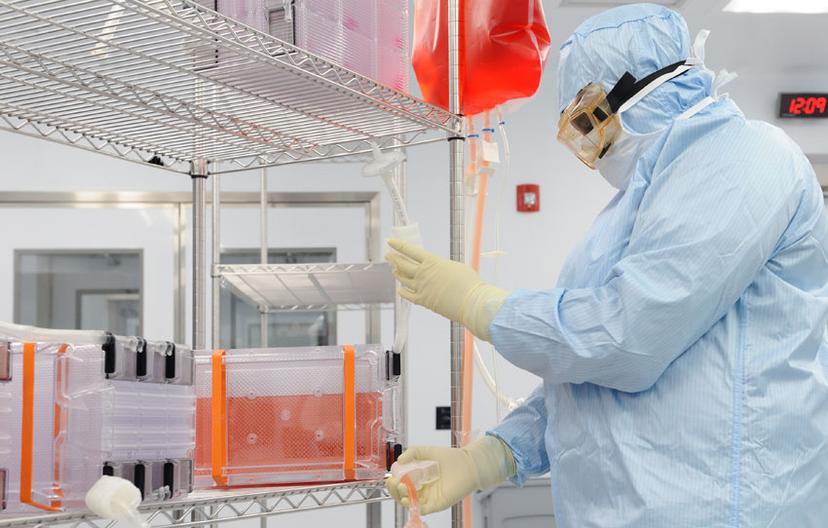Gene Therapy: New Treatments Reprogram Patients’ Immune Cells
Dr. Joseph Hughes describes how WuXi Advanced Therapies scales up viral vectors to help customers expedite entry of gene and cell therapies into clinical trials
10 Dec 2018Gene and cellular therapies are at the forefront of several recent clinical trials for many patient conditions including hematologic cancers, solid tumors and metabolic diseases. Likewise, demand continues to grow for viral vectors, which are used to introduce new genes that reprogram or alter cells. Viral vectors need to be produced and purified rapidly, in relatively high volumes, at high doses and in aseptic environments. Customized, high-yield, closed-cell growth and purification systems are enabling new therapies to rapidly enter patient trials.
In this SelectScience® interview, we speak with Dr. Joseph Hughes, Chief Scientist and Vice President, Process and Analytical Development, at WuXi AppTec. He’s based at the Philadelphia, USA main site for the Advanced Therapies unit, where they focus on these biotherapeutic drugs.

WuXi AppTec is a leading global pharmaceutical, medical device open-access capability and technology platform company. With its capabilities in small molecule R&D and manufacturing, cell therapy and gene therapy R&D and manufacturing, and medical device testing, the WuXi platform is enabling more than 3,000 innovative collaborators from over 30 countries to bring innovative healthcare products to patients. The vision of the Philadelphia-based Advanced Therapies Unit is to “accelerate progress and reduce time to market” through enabling, integrated platforms using technologies such as the Corning® HYPERstack® culture vessels.
Check out these useful resources for gene therapy and viral vector production >>
- Article: Gene Therapy is Closer Than We Think – A Success Story
- Method: Amplifying Adenoviral Particles in the Corning HYPERStack Cell Culture Vessel
- App note: Corning HYPERStack Cell Culture Vessel: Performance Analysis
Along with his Ph.D. in virology, Hughes brings vital experience to the company, from both the pharmaceutical industry and academic sides of this field. “I first worked on viral vaccines and anti-viral therapies at Merck, and witnessed all the expertise required to bring a product to clinical trial stages and ultimately commercialization. From this combined perspective, I understand the requirement in the U.S. and abroad for scientific research, clinical considerations, quality systems and regulatory submission. As Associate Director for Translational Research at the University of Pennsylvania, I led a team that made viral vectors for toxicology and human use, performed in vivo studies and helped write applications to begin phase I clinical studies for cancer and gene therapy,” he says.
In January 2018 at WuXi, Hughes’ team of process developers and analytical staff became part of the newly-formed, Philadelphia-based Advanced Therapy Unit (ATU), specializing in cell and gene therapies. “We work with large pharmaceutical companies, as well as smaller biotechs, helping to expedite their products rapidly toward clinical trials. Many of these partners are developing autologous cell therapies, manufactured as a single lot from the patients being treated, while others focus on allogeneic cell therapies. Many of these therapies utilize viral vectors; the two most common we employ are lentivirus- and adeno-associated virus (AAV)-based,” Hughes explains.

WuXi ATU also manufactures tumor-infiltrating lymphocytes (TILs) for some of its clients, including Iovance Biotherapeutics, a clinical trial phase company focused on novel cancer immunotherapies. TILs, white blood cells found at low levels inside tumors, require neither reprogramming nor viral vectors. To be effective, however, the cells are needed in much higher numbers. Hughes adds: “After removing primary cells from a patient’s tumor, we select, isolate and expand the TILs before returning them to the patient. Theoretically, the tumor environment somehow suppresses the lymphocytes, which otherwise should attack and destroy it in a specific manner. Data from melanoma, ovarian cancer and other solid tumors supports this hypothesis.”
The smaller, yet more efficient footprint meant we could maximize the space in our incubators and in our manufacturing suites.
Dr. Joseph Hughes Chief Scientist and Vice President, WuXi AppTec

Of course, substantial numbers of cells are needed to produce viral vectors in sizable quantity. Hughes explains why they started using Corning HYPERStack culture vessels: “Five or six years ago, we were working with pharmaceutical companies that needed much larger amounts of cells. Some customers were using cell culture vessels with fewer layers, when we realized the Corning HYPERStack offers substantially more. The smaller, yet more efficient footprint meant we could maximize the space in our incubators and in our manufacturing suites. Also, Corning’s CellBIND surface treatment optimizes cell attachment and growth, producing larger numbers compared to other plastic coatings or treatments. We now manufacture significantly more cells than you can with many of the other available systems, which is a huge advantage.”
When WuXi ATU began to use this process for patient cell therapy, Hughes and his team wanted to optimize the manufacturing process to ensure the aseptic nature, and thus safety of products intended for the clinic. “To eliminate any potential risk of contamination, we designed a modified, custom closure adaptor in partnership with a team from Corning. Starting from a single vial of frozen cells, this system now provides a process to manufacture a sizable amount of lentivirus vector in a completely closed system. The improved design also eliminates risk of loss due to filter sterilization. With 60 of the 36-layer HYPERStacks we harvest a large volume of virus vector, about 250L. The downstream processing — clarification, removal of cellular DNA, buffer exchange and filling into vials or bags — is all part of the closed system. That means a functionally sterile product emerges from the end of the process.”
Hughes adds: “Corning offered a lot of technical help when we first started, with advice on the best way to grow cells, pour off media and collect the cells. Now, we have a lot of expertise here and they were very accommodating in getting us to that point; we have continued with a good relationship with Corning.”
Hughes thinks more companies will continue to enter the cellular therapy market, both for autologous and allogeneic therapies. “It’s not a cure for everybody, but certainly with some hematologic cancers, the trend for a high percentage of cures is continuing. We are also investigating therapies for solid tumors, and working with companies using gene therapy for genetic diseases, either adding a gene or trying to inactivate a gene.” These approaches offer the potential to address ocular, muscular, metabolic and other specific diseases, and will likely depend on a variety of different viral vectors. The WuXi team is poised to help many different companies get into clinical trials and to the market quickly.
Learn more about the Corning HYPERStack Cell Culture Vessel in this downloadable app note that describes the method in detail.
